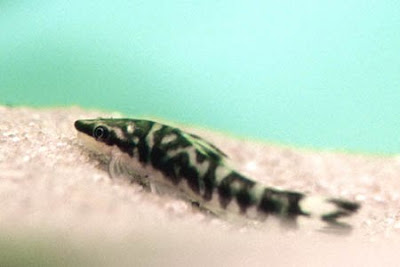Popular Algae Eating Fish for Aquarium: Zebra Otocinclus
Popular
Algae Eating Fish for Aquarium: Zebra Otocinclus – Named for the Cocama - Cocamilla Indian
tribes that used to be dominant in the low Ucayali and lower Marañon region of
Peru, tropical fish also refers to as Zebra oto or the Tiger oto Otocinclus
cocama keeping enthusiasts.
 |
Photo copyright from tropicalfishfinder.co.uk
|
Popular Algae Eating Fish for Aquarium: Zebra Otocinclus
Colour of the body is
beige-gray. These stripes are dashed and they create a pattern like a zebra's
stripes. The head of the fish is almost completely dark. The fish has
beige-yellow under-side. External rays of the caudal fin are elongated. The
caudal fin has dark border which looks like ”w” letter. Other fins are clear.
When they are sexually developed, the sex of the fish can be comprehended.
Female is thicker than male in the ventral parts.
The fish is located in
small to mid size tributaries and in the slow flowing marginal zones of larger
rivers, clear water creeks of the Ucayali River and possibly the Marañón River.
They appear in large numbers in regions with aquatic vegetation or grasses
growning close to the surface among the plant life in the top part of the water
column, usually in the water.
Diet
Vegetarian, it feeds on
algae and aufwuch . When introduced to an aquarium, there should be a good
supply of common green algae or diatoms (brown algae) present or a great
biofilm on plant leaves and other surfaces such as in an established aquarium,
otherwise the fish may well starve. It'll feed from sinking foods for example
algae, spirulina, kelp tablets and disks once acclimated.
Vegetables like
blanched spinach, cucumber and zucchini might be offered. It is going to eat
other foods but mustn't be fed a diet lacking in vegetable (alga, etc) matter.
Distribution and Habitat
This fish is found in
Peru in the Ucayali River and maybe Marañón River also. These fish are seen in
mid-sized creeks with water that is clear. Marginal plant life is associated
with by them.
Care
This lovely miniature
Loricariid is an ideal species to get a calm softwater put aquarium. In the
wild it's located in the borders of clearwater creeks amongst dense vegetation.
This is a peaceful fish which is best kept in great sized groups (6 ) in a
mature aquarium with lots of shady hiding places amongst plants, driftwood, and
slate caverns.
Avoid tankmates that are
boisterous at feeding times, as these shy small catfish will not compete well.
As with other Otocinclus, this species could be rather fragile when first
imported - consistently ensure new arrivals are well rested, and quarantine any
new purchases to make sure they settle in well before adding to the primary
aquarium.
Tank Mates
The Zebra oto can be
differentiated from other members of Otocinclus by its own lateral line that is
complete and its blotchy perpendicular stripes. The Zebra oto has the most
quantity of teeth of any species of Otocinclus, and except for Otocinclus
batmani, the Zebra oto is distinguished by the “W” looking mark on its caudal
fin from all the species of Otocinclus.
Reproduction
We don’t have some
information about breeding these fish in the aquarium. They're imported and
they really slowly adapt to life in captivity. After putting them in the
aquarium, they're able to expire without the reason within six weeks. You need
to create for these fish pressure-free conditions and feed them great quality
and diverse food made of plants and vegetables.



Komentar
Posting Komentar